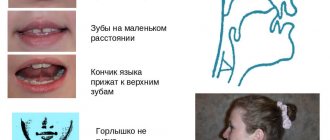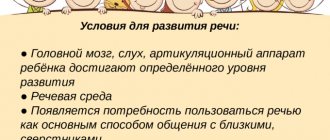In Iktor Dragunsky wrote a funny story “The Enchanted Letter”. Three friends Alyonka, Mishka and the author (as children) saw a truck bring a Christmas tree into the yard. The girl exclaimed enthusiastically: “Look, there are detectives hanging on the tree.” The boys laughed - Alyonka was offended and began to make excuses that the tooth had fallen out, that’s why she said “detective”
.
To which Mishka answered her: “I have three that fell out, and two are wobbly, but I still say it correctly!” Listen here: giggles!
“The guys began to argue until they cried over who was right.
The author of the story, looking at them, laughed for a long time. On the way home, he thought: why were his friends arguing, because the word is simple: “There are no detectives
.
No naked
, but briefly and clear:
Fyfki
! "
The guys, of course, spoke correctly, they just mixed up some sounds.
Perhaps, many parents also noticed that their kids replace whistling ones with hissing ones (shanki - sleds) and vice versa (detectives - shishki). This lack of pronunciation of whistling sounds (S-S', Z-Z', C) and hissing sounds (Ш, Ж, Х, Ш) is called sigmatism. Both groups of sounds appear by 4-5 years. Hissing sounds are considered more complex in articulation and are placed after whistling sounds. A speech therapist corrects pronunciation. But any training with a specialist is reinforced at home. In this article we will tell you about important steps that will help your child disenchant S and Sh faster.
Sh pronunciation is normal
This sound is the basic one in the hissing group. Having mastered its articulation, the child will easily learn to correctly pronounce other sounds from this group. The lips take a “horn” position: they are pushed forward a little so that a “window” shape is obtained. When pronouncing a sound, the teeth must be closed.
The tongue should be in a “cup” position: the tip is behind the upper teeth, and its sides are pressed tightly against the teeth. This allows you to direct the exhaled stream in the middle. If everything is done correctly, it will turn out wide and warm. The vocal cords are open, so Ш is a voiceless consonant.
general information
The production of any sounds takes place in four stages and none of them can be skipped.
Before any work, a complete examination of the child’s speech condition is required. The speech therapist will check all sounds and note the degree of defect (replacement, distortion, etc.). Then the syllable structure is checked. To do this, the child is shown pictures whose names consist of syllables of varying complexity. For example, “mom”, “dad” and others. More difficult ones - “branches”, “sleds”, etc.
The next stage is studying the phonemic side of speech. To do this, show the preschooler different pictures and ask him to name the first, last sound, or find all the pictures for a given sound.
The next stage is an examination of vocabulary, that is, vocabulary. They are shown a group of objects and asked to classify it. For example, “this is furniture” or “this is dishes.”
At the final stage, they are asked to compose a story based on the picture. Based on the information received, the speech therapist makes a conclusion and determines the goals of correctional work.
Preschoolers must have their speech organs checked. The tone (increased or decreased), structural features, as well as the length of the hyoid ligament are noted.
The peculiarity of dysarthria is that it causes various breathing problems. Because of this, speech is poorly colored, almost devoid of emotion and expressiveness.
Types and mechanisms of violations
Incorrect pronunciation of a hissing group is called sigmatism, and their replacement with other sounds is called parasigmatism. Sh may be absent from a child’s speech, but he will not replace it with other phonemes. There are several types of hissing sigmatism, differing in the mechanism of occurrence:
- Interdental – speech with such distortion is called a lisp. With this sigmatism, the tongue does not take the desired “cup” position, but passes between the teeth. The cause may be a short hyoid frenulum; high and narrow sky.
- Lateral - in speech, instead of Ш, a sound is produced that has a “squelching” sound. During pronunciation, one corner of the lips rises higher than the other; the lower jaw is also shifted to one side; the “cup” shape does not work out because the back of the tongue forms a connection with the dental alveoli on only one side. The reason for the appearance of such distortion may be weak tone of the articulatory muscles and incorrect bite.
- Nasal - instead of Ш, the child pronounces X with a nasal connotation. The tongue is in a lower position, and the back is raised up. It is because of the high tension on the back of the tongue that this sigmatism appears.
Depending on the type of hissing sigmatism, the speech therapist will select the method of sound production.
Methods for preventing the disease
Due to the biological factors in the development of the disease, it is worth thinking about its prevention during pregnancy and childbirth. Difficult pregnancy, intrauterine infections, asphyxia, complicated childbirth, injuries in the first months of a newborn’s life - all this can cause speech disorders in the future.
We list the main methods of preventing the disease after the birth of the baby.
First, develop your reflexes. These include gaze fixation and object tracking, auditory concentration, motor activity, and the oral automatism reflex - all of them are very important in the development of the newborn.
Secondly, communicate with the baby. Tactile, visual, auditory sensations - all this is extremely important for its development. Smile at him, talk to him, carry him in your arms, stroke him.
Third, be always there. This is especially true for mom. After all, a newborn needs her closeness, the opportunity to touch her, see her, feel her, and receive a return hug.
Fourth, stimulate the sucking reflex. The more actively and longer the baby suckles at the breast, the better its muscles develop - they become stronger and more flexible.
Fifth, encourage the baby's attempts to communicate. Humming and babbling - this needs to be stimulated.
Sixth, develop fine motor skills. Speech is directly related to fine motor skills and the more dexterous the baby’s hands are, the better. Introduce him to different textures.
Seventh, speak to your baby in your native language. Speak clearly and competently. And encourage him to communicate. Even if he doesn't talk, still try to make him make sounds. If he wants something and shows it with gestures, provoke him to ask for it verbally.
Speech therapy diagnostics
The speech therapist evaluates the development of all components of speech to determine a speech defect. In case of distorted pronunciation of sounds during diagnosis, he pays special attention to:
- appearance of the lips, state of the bite, muscle tone of the tongue;
- articulatory and facial motor skills;
- duration and force of exhalation;
- pronunciation of sound in isolation, in syllables, words, phrases and coherent speech;
- whether the child distinguishes it from other phonemes.
When assessing the anatomy of the articulatory apparatus, the specialist looks at the bite, palate, appearance of the tongue (too narrow or clumsy wide), and the hyoid frenulum. If there are any deviations that may be the cause of the distortion, the speech therapist can refer you to other specialists (surgeon, orthodontist).
When checking the work of facial muscles, the speech therapist asks the child to depict emotions (joy, sadness, surprise, etc.); checks how the facial muscles work individually (asks you to raise your eyebrows, smile, etc.); In addition to motor skills, the child is shown images of various emotions and must choose the appropriate mood for each picture.
During the diagnosis of articulatory motor skills, the speech therapist gives tasks for statics (retention) and dynamics:
- Smile, stretch out your lips in a “tube” or take a position as when pronouncing O. You need to fix them in a certain position for a few seconds.
- Move your jaw in different directions.
- Relax your tongue, make it wide, place and hold it on your lower lip, or make it narrow, extending it as far as possible.
- Perform the “cup” exercise.
- Raise - lower the tongue.
- Move them in different directions.
- Draw a horse.
All exercises are performed by demonstration, that is, the adult shows first, and the child then repeats. The speech therapist notes from what time the child was able to complete the task correctly or when he failed; draws attention to the state of muscle tone of the articulatory apparatus.
To check the strength and duration of exhalation, it is suggested to perform the following tasks:
- blow off a light object (feather, piece of cotton wool);
- play the game “Who will kick the ball further” - the child competes with an adult who will blow out the object further;
- play the pipe.
Before performing tasks, the speech therapist explains how to breathe correctly. During diagnosis, he also pays attention to the formation of speech breathing.
When examining the sound-pronunciation aspect of speech, the speech therapist examines all groups of sounds. When a child pronounces a sound, the speech therapist pays attention to the position of the articulation organs. At first, the phoneme is pronounced separately from the others. Then in various syllables (SHA, OSH, USHU, ShPA, etc.); in words, and the sound must be at the beginning, middle or end (HAT, MOUSE, RESED, etc.).
Then the speech material is complicated, and the child repeats phrases and sentences after the adult (BIG EARS, DASHIN'S FUR COAT, WIDE SCARF, etc.). To check the pronunciation of Ш in independent coherent speech, use the following tasks:
- make up a phrase/sentence from the given words;
- who can name more objects that have Sh in their names;
- tell what is drawn in the plot picture.
Speech and visual material should be selected taking into account the child’s age. When checking the pronunciation of a particular sound, you do not need to use words containing mixed groups and oppositional phonemes.
The speech therapist also checks the state of phonemic hearing and the skill of sound-letter analysis. For this purpose, special tasks are selected:
- do some action after hearing a given sound (it is pronounced separately, in combination with other phonemes);
- Determine the position of a sound in a word.
Based on the results of the examination, the speech therapist draws up a plan of correctional work and selects appropriate methods of sound production.
conclusions
Dysarthria is not just a failure to pronounce certain sounds. And you certainly shouldn’t expect a child with such a diagnosis to “talk” like the neighbors’ daughter. This speech disorder is much deeper and more complex, but it is not always a death sentence. The main thing is not to waste time.
This is why turning a blind eye to the problem is a huge mistake as parents. Of course, it is difficult to accept the fact that your child has some kind of impairment. But this must be done precisely for the benefit of the future of your baby. An untreated disease will bring many problems to an adult in social life - from communication to work.
If the disease is detected at an early stage of development, it can be cured. An integrated approach to therapy gives good results. Of course, if there are no gross disorders of the nervous system.
It is even better if it was possible to diagnose the disease when it has not yet made itself felt, that is, before the baby’s first attempts to speak. Such early corrective work will become effective prevention.
Articulation and breathing exercises
Before moving on to sound production, the desired articulatory pattern is formed and the strength and duration of exhalation is trained. To pronounce sibilants correctly, the child is taught to make his tongue wide and raise it. The main exercise in the complex is “Cup”. It is this position that forms the basis for the correct articulation of sibilants.
You can begin to perform it once you have developed the ability to make and keep your tongue wide.
First, the classes develop the ability to relax the tongue. To do this, perform patting movements with your lips or lightly bite them with your teeth - these are options for self-massage. They also train in holding the tongue in this position for some time. If difficulties arise with lifting it, select exercises to practice the upper position (“Horse”, “Mushroom”, “Brush your upper teeth” and other similar tasks).
After the child succeeds in all of the above, they begin to perform the “Cup” exercise. The child raises the tip and lateral edges of the tongue and holds them in this position. To increase the effect, you can pour a little water into the “Cup” so that the baby tries to hold it.
Other exercises are also recommended:
- To complete this task you will need cotton wool. A wide tongue is placed on the lower lip. The child says an elongated F and tries to blow off the cotton wool as far as possible.
- The wide tip of the tongue is placed on the upper lip, and the side edges should be pressed tightly. A piece of cotton wool or a feather is placed on the tip of the nose. The child tries to blow it off by holding his tongue in the upper position. He will be able to do this if the air stream passes through the middle.
The listed tasks are aimed not only at developing a long exhalation, but also develop the ability to relax the tongue, make it wide, and in this state lift and hold it behind the teeth. When the speech therapist sees that the child can maintain the necessary articulatory postures, he begins to set the Sh. If the movements are not sufficiently formed and the muscles of the tongue are not strengthened, then the child will not be able to fix the correct position, and the sound will be pronounced only with mechanical assistance. Therefore, the preparatory stage is mandatory in correctional work.
The described exercises for sibilants are also used to correct the pronunciation of a sonorant group of sounds, because when they are pronounced, the tongue also takes an upper position.
A set of articulation exercises
The exercise includes 5 exercises and can also be done at home.
“Horse” - clicking the tongue. This is a very useful and effective exercise. Not all children get it right away.
“Pancakes” - the baby opens his mouth slightly, spreads his tongue into a flat pancake.
“Snake” - the child imitates the sting of a snake - the tongue is just as sharp. Then he sticks it back and forth.
“Tube” - the baby tries to roll his tongue into a tube.
Another exercise is to try to reach the tip of your tongue to your nose and then to your chin.
Setting option when there is no sound
If a child does not have Sh in his speech, and he does not use other phonemes instead, then the main emphasis is on articulatory gymnastics, namely the formation of a wide tongue rise. When the “Cup” exercise is performed correctly, the speech therapist begins to produce sound.
He asks the child to make a “Cup” and hide his tongue behind his teeth. Next, the speech therapist explains that you need to blow on your tongue and then you will get Sh. If the child pronounces X, then a clear hissing sound will not be produced. For convenience, they suggest pronouncing C, only the tongue is behind the upper teeth. To develop the correct pronunciation, you need to repeat it many times. To increase the effectiveness of classes, the speech therapist uses didactic games.
A set of breathing exercises
Includes 2 exercises. Parents can easily do them with their baby at home.
"Racing" . Place two cotton balls on the table. The parent blows on one balloon, the child on the other. The one who moves his ball the greatest distance wins.
"Magic Breath" . Insert pieces of cotton wool into the baby's nostrils. The main thing is not deep! Ask him to exhale and at the same time hold the cotton wool - it should not fall out.
Another version of breathing exercises is according to A.N. Strelnikova. The essence of gymnastics is to take a sharp breath through your nose every second and do the exercises at the same time. The inhalation is noisy and strong, and the exhalation is natural, imperceptible.
There are several rules: with each inhalation, lower your shoulders and close your nostrils tightly, as if someone is pressing on them.
Gymnastics should be a joy, so you need to do it until the first signs of fatigue. There is no need to force your child if he does not want to study.
Gymnastics is designed for adults, so the duration of the lesson and the number of approaches is best agreed upon with a speech therapist.
Setting Sh with distorted pronunciation
The method of presentation depends on the type of sigmatism. Each of them has its own reasons, so the speech therapist selects techniques to correct them:
- With the interdental variant, exactly the same preparatory work is carried out as in the absence of a phoneme in speech. The emphasis is on raising the tongue, so they additionally practice clear pronunciation of T, from which the sound will be made. When pronouncing T, the child keeps his mouth open. You need to pronounce the sound slowly, adding aspiration. Gradually, the speech therapist teaches the child to lengthen the air stream and not touch the tubercles with the tongue.
- For lateral distortion, a mechanical method is used. Before insertion, the lateral edges of the tongue are strengthened; They teach you to raise and hold your tongue behind your teeth, and form a strong, long, directed exhalation. For placement, you can use a special speech therapy probe or a teaspoon (if you are doing correction at home). Using a probe or spoon, the front part of the tongue is lifted and removed behind the upper teeth, moving it closer to the tubercles. The child bites the spoon and pronounces S. Gradually, the duration of exhalation increases, and the ability to lift and hold the tongue in the desired position independently is formed.
- The method of setting from P - this method is rarely used, because to pronounce a sonorant group the tongue occupies a similar position as for sibilants. Therefore, few children can speak R correctly if they have problems with the pronunciation of sibilants. The child, keeping his mouth open, pronounces R silently. An adult, using the handle of a teaspoon, stops the vibration. The result is hissing. Gradually, the spoon is used less, the child learns to keep his teeth together and make a hissing sound without mechanical assistance.
- Method of setting from whistlers. The child pronounces an elongated S, the adult places a teaspoon or probe under the front edge of the tongue, lifts it and moves it deeper into the mouth until he hears Sh in speech. Gradually, the child learns to independently lift and cup his tongue.
If there are disturbances in the tone of the tongue muscles, a course of speech therapy massage is prescribed. It is performed using probes (for this you need to undergo special training) or fingers wearing sterile disposable gloves. But along with the massage you need to do articulation gymnastics. Then the preparation of the organs of articulation for the production of Ш will be more effective.
The sound Ш is the main one in its group. Therefore, having corrected its pronunciation, it is easy to add other sibilants. You just need to explain the difference in articulation so that the child does not mix them up in speech. You need to start producing other hissing sounds when you have passed the stage of automating the sound Ш in speech.
We train to navigate in space
- “Whose traces?” . Pictures with traces of hands and feet are needed. The baby must determine which arm or leg is right and which is left.
- "Supermarket" . The parent asks the child to arrange the goods: “on the shelf”, “near the cash register”, “to the right of the cookies”, “under the counter”.
- Counting sticks. Can be replaced with matches. The parent makes some figure out of them, and the baby makes a similar one according to the image.
This complex can also be performed at home.
Basic moments
The sequence of sounds may vary. Some experts suggest starting with vowels, then moving on to consonants. Chirkina recommended starting with the group for which the articulatory apparatus is ready.
To start making the sound “Ш” for dysarthria or others, you need to complete several tasks. Their goal is to prepare the ground for work.
Parents should prepare for the fact that it will take months of work to eliminate the violation.
The specialist is engaged in the development of:
- hearing;
- breathing;
- speech organs.
It is these three components that provide the basis for the pronunciation of certain sounds. Without them, the child will not hiss or whistle, not to mention growl.
Classes in kindergarten are conducted both in groups and individually. To increase work efficiency, parents also work at home to consolidate certain skills.
Front-lingual sounds
With dysarthria, all groups of sounds often suffer. For example, “D”, “T” and their soft pairs. Various techniques are used for correction. Before this, the mobility of the lower jaw must be developed. The tip of the tongue should rise towards the upper teeth.
To produce the sound “D” in a child with dysarthria, the following technique is used: they are asked to pronounce “B” for a long time and at this time the tip of the tongue is carefully lifted with a spatula. Afterwards, attention is focused on auditory perception.
Sometimes correction of the “T” sound in the interdental position is allowed. To do this, ask the preschooler to tap his tongue between his teeth and say “ta.” Over time, the tongue will retract itself behind the teeth.
For each group, staging techniques may be different. For example, it is advisable to insert back-lingual ones (“K”, “G”, “X” and soft pairs) with a special probe that will move the tongue deeper into the mouth.
Sound [sh]
Preparatory stage
Lesson 1
Spatial orientation
Cross orientation.
- Place your right hand on your left shoulder. Place your left hand on your right knee. Touch your left ear with your right hand. With your left hand touch your right cheek.
“We go up the mountain, we go down the mountain.” Pronunciation of syllables in combination with movements of the index finger.
Exercise to develop a long exhalation
“Let’s warm our hands.” Take a deep breath through your nose. Round your lips and exhale forcefully through your mouth. A warm air stream should be felt. Repeat 3-4 times.
Lip exercise
"Astonishment". Round your lips and pull them forward. Make the sound [o].
Tongue exercises
“The tongue is looking for a crack in the fence.” Insert a wide tongue into the gap between the teeth.
"Spatula". Smile, open your mouth slightly, place the wide front edge of your tongue on your lower lip. Hold in this position for a count of 10.
Coordination of breathing, articulation and phonation
Game tasks
"The boat rocks on the waves." Drawing wavy lines in a box of millet cereals.
Development of phonemic awareness
Isolation of the sound [ш] from a number of sounds that are distant in terms of acoustic and articulatory characteristics. Sounds: [v], [w], [l], [sh], [p], [b], [f], [sh], [m], [n], [sh]. Syllables: la, sha, fu, wu, po, ko, by, gy.
The words
hat, lump, fur coat, jar, shirt, raspberry.
Lesson 2
Exercise to develop a long exhalation
"Football". Take a breath. Smile and place the wide front edge of your tongue on your lower lip. Using an exhaled air stream, drive the cotton ball into the “gate”.
“Let’s put out the candle.” Exhale evenly and slowly into the candle flame.
Pronouncing vowel sounds a-i, a-u, e-s-o
on one exhalation with exaggerated articulation.
Lip exercises
"Wide tube" Close your teeth. Round your lips extended forward. The corners of the lips do not touch. Lips do not cover teeth. Hold your lips in this position for a count of 6.
Tongue exercises
"Delicious jam." Open your mouth slightly. Using the wide front edge of your tongue, lick your upper lip, moving your tongue from top to bottom. Repeat 5-6 times.
“The tongue goes to visit the nose.” Open your mouth slightly, lift the wide front edge of your tongue towards your nose. Hold it in this position for a count of 5-6.
“Teeth and tongue playing hide and seek.” Open your mouth slightly, cover your upper teeth with your tongue.
Development of switchability of the organs of the articulatory apparatus and development of coordinated work of the lips and tongue
"Conversation between the Cuckoo and the Owl." Pronouncing syllables and sounds ku-ku, ku-ku, ku-ku; uh, uh, uh
with a change in intonation.
Development of phonemic awareness
Isolation of the sound [w] among sounds that are similar in acoustic and articulatory characteristics, against the background of syllables and words. Sounds: [s], [sh], [z], [s], [sh], [ts], [zh], [s]. Syllables: sa, for, zha, so, sha, tso, su, shu, zy, shi, sy.
The words
cuckoo, owl, sparrow, fox, beetle, bumblebee,
etc. The child raises his hand or claps his hands if he hears the sound [w].
Lesson 3
Exercise to develop a long exhalation
Close the wide tongue on the upper lip, bring a strip of paper (just above the nose). Blow on a paper plume (the air stream should go obliquely upward).
"The plane is buzzing." Pronunciation of the sound [u] with changes in the pitch and strength of the voice.
Lip exercise
Alternating exercises “Smile” and “Pipe”.
Tongue exercises
“The tongue swings on a swing.” Open your mouth wide, raise your wide tongue to your nose, then lower it to your chin.
“Let’s hide our teeth.” Cover the upper teeth with a wide tongue, then the lower ones.
“Glue on some candy.” Place a piece of candy on the edge of your tongue sticking out of your mouth. Suggest sticking it to the roof of your mouth behind your upper teeth.
Development of switchability of the organs of the articulatory apparatus and development of coordinated work of the lips and tongue
"We play the drum." Pronouncing syllable combinations ta-da, ta-da, ta-da, ta-da, you-dy, you-dy, you-dy
with the movement of the index fingers of both hands.
Development of phonemic awareness
Definition of the sound [ш] in words. Find toys that have the sound [sh] in their names. ( Matryoshka, rattle, Cheburashka, bear, car, ball.
)
Determining the position of the sound [sh] in the words ball, bear, baby.
Lesson 4
Exercise to develop a long exhalation
"Focus". Place a piece of cotton wool on the tip of your nose. Smile, open your mouth slightly. Place the wide front edge of the tongue on the upper lip so that its side edges are pressed and there is a “groove” in the middle. Blow off the cotton. The air should flow through the middle of the tongue, then the cotton wool will fly upward.
Lip exercise
"Elephant's trunk". Round your lips and pull them forward. Hold your lips in this position for a count of 6.
Tongue exercises
"Swing". Raise and lower your wide tongue behind your teeth, touching it with the tip of the upper gum, then the lower gum.
Place the tip of your tongue under your upper lip, then tear it off with a click.
"Cup".
- Prepare a “cup”, I will treat you with juice. What juice will you drink?
— Open your mouth slightly, place your wide tongue on your lower lip, then lift the tip and lateral edges of the tongue upward; a depression should form in the middle part of the tongue.
Development of the voice, switchability of the organs of the articulatory apparatus and the development of coordinated work of the lips and tongue
"Conversation between the piglets Naf-Naf and Nuf-Nuf." Pronouncing the syllables na-na-na, ny-ny-ny, well-well-well, but-but-but
with a change in stress and intonation (fearful, confident, angry, calm).
Development of phonemic awareness
Find pictures on the topic “Clothing” whose titles contain the sound [w]. Determining the position of the sound [sh] in the words hat, scarf, shirt, pants, shower.
Arrange the pictures on the typesetting canvas. Place objects in whose names the sound is heard at the beginning of the word on the top strip, on the middle - those whose names have the sound in the middle, on the bottom - those whose names have the sound at the end.
Lesson 5
Exercise to develop a long exhalation
“A strong wind blows the leaves.” Place a wide tongue (“shovel”) on the lower lip. Blowing with the formation of a “groove” along the midline.
Lip exercise
"The trunk of a large elephant and a small elephant." Alternating wide and narrow “tubes”.
Tongue exercises
Repetition of exercises from previous lessons.
"We're riding a horse." Clicking the tongue. The wide tip of the tongue is sucked to the palate and comes off with a click.
"Rose petal". The tongue is cupped on the outside, then inside the mouth. Make sure that the lateral edges of the tongue are pressed against the upper molars.
Development of switchability of the organs of the articulatory apparatus and development of coordinated work of the lips and tongue
"Conversation of Hippos." Pronouncing syllable combinations bda-bda, bdo-bdo, bdu-bdu, bdy-bdy; bda-bdo-bdy, bda-bda-bdu-bdy
with a change in intonation.
Development of phonemic awareness
Determination of the position of the sound [sh] in the words Shura, Masha, Natasha, strong, short, silly, naked.
Lesson 6
Exercise to develop a long exhalation
"The wind is rustling." Place the bottle upside down at nose level. Raise your wide tongue to your upper lip and blow strongly on your tongue. Noise is heard in the bubble.
"The baby elephant drinks some water." Make a “proboscis”. Inhale and exhale air through your mouth.
Lip exercises
Repetition of exercises from previous lessons.
Development of coordinated movements of the lips and tongue. Extend the lips into a “tube” and the tongue into a “cup” (outside the mouth).
Tongue exercises
Repetition of exercises from previous lessons.
"Harmonic". Smile, open your mouth slightly. Glue your tongue to the roof of your mouth, then, without lowering your tongue, close and open your mouth. As you repeat the exercise, open your mouth wider and hold your tongue longer.
Development of switchability of the organs of the articulatory apparatus and development of coordinated work of the lips and tongue
Hippo Booby learns to pronounce the syllables bdi-bdi-bdi, bdi-bde, bdia-bde, bde-bdia-bdi.
Development of phonemic awareness
Selecting pictures whose names contain the sound [w] from other pictures whose names contain [s] and [z]. The teacher pronounces the words, and the child chooses pictures whose names contain the sound [w].
Sound setting [w]
The position of the organs of the articulatory apparatus when pronouncing the sound [w] correctly
The lips are slightly rounded and extended forward like a tube. The teeth are brought together at a distance of 1-2 mm. The tip of the tongue is raised in a “cup”, but does not touch the palate. The lateral edges of the tongue are pressed against the upper molars, and the middle of the front of the tongue forms a semilunar fissure with the palate just behind the alveoli. The soft palate is raised, the vocal cords are open. The exhaled air stream is strong. If you put the back of your hand to your mouth, you feel warmth.
Techniques for sound production [w]
Auditory perception of sound. Creating an auditory image of the sound “Noisemakers”. Onomatopoeia
The sound of the wind in the forest; the rustle of leaves on the trees; rustling of dry leaves; rustling of dry hay or straw, paper; the hiss of a gander, a snake; the rustling of mice in a hole, tires on the pavement; the sound of air escaping from a punctured balloon, a locomotive releasing steam.
Formation of a visual image of sound [w]
Articulation profile display. Clarification of the position of the lips, teeth and tongue. Description of the position of the organs of articulation.
Forming a sense of the position of the organs of articulation with the help of toys. Look how the monkey lifts its tongue “cupped” by its upper teeth.
еёё129 Drawings for tasks used at the sound automation stage [с]
Demonstration of correct articulation of the sound [sh]. Draw the child's attention to the position of the lips, teeth and tongue.
Plastic image of the shape of the tongue using the hands
With your right hand, draw a “cup” shape of the tongue, and with your left hand, the palate.
Setting the sound [w] according to R.I. Levina (1965)
Setting the sound [sh] by imitation
Raise your tongue to your upper lip and exhale air evenly and forcefully, controlling the air stream with the back of your hand.
Having achieved the release of a warm stream of air from the position of the tongue at the upper lip, move the tongue over the upper teeth to the palate with the mouth open. Round your lips and stretch them forward, bring your teeth together at a distance of 1-2 mm and exhale. The sound should be [w].
Arranging the sound [sh] based on the sound [t]
Pronounce the sound [t] several times at intervals of 2-3 seconds. Then the setting is given: the tongue “knocks” not on the teeth, but on the tubercles (alveoli). The sound [t] is pronounced at first with an aspiration, while a weak and short hissing sound is mixed with the sound of the explosion.
Round your lips and extend them forward, raise your tongue to the front of the palate. Press the lateral edges of the tongue against the molars. Transition from the sound [t] to the sound [w]: t-t-tshshsh.
Subsequently, the noise lengthens and is freed from the previous sound [t].
Arranging the sound [w] based on the sound [r]
Make a drawn-out sound [r] without a voice or in a whisper, gradually reducing the force of exhalation until the vibration stops and a faint hiss appears. With repeated exercises, the sound [w] is obtained without the previous pronunciation of a dull sound [r].
Hissing can be obtained by touching the lower surface of the tongue with a spatula, slowing down the vibration of the tongue.
Arranging the sound [w] based on the sound [s]
Place your tongue behind your lower teeth. Invite the child to pronounce the sound [s]. At the same time, use a spatula or probe to lift the tongue upward. Using the fingers of your right hand, lightly press on your cheeks and push your lips forward. Instead of a whistle, you should get a hiss. You can invite the child to repeat the syllables sa, so, sy, asa, asy, as, os
with simultaneous lifting of the tongue with a probe or spatula.
Arranging the sound [w] based on the sound [h]
Make the sound [h] followed by a long exhalation. You should feel a warm stream of air on your hand brought to your mouth.
- Automation of the sound [Сь] in forward and backward syllables
- Sound automation [Сь] in isolated form
- Automation of sound [C] in isolated form
- Automation of the sound [С] in reverse syllables
- Automation of the sound [С] in straight syllables
- Speech material for automating the sound [С] in phrases and sentences
- Automation of sound [С] in words
- Summary of an individual speech therapy lesson Topic: “Automation of the sound [S] in syllables, words, sentences”
- Summary of individual lessons. Topic: “Sound Automation [R]”
- Automation of sound [Ш]
- Sound automation [H]
- Sound automation [F]
- Sound automation [Ш]
- Summary of individual speech therapy sessions. Topic: “Automation of the sound [L] in syllables, words, sentences”
- "Automation of the [S] sound in syllables, words and phrases." Summary of an individual developmental lesson on the correction of rhinolalia









